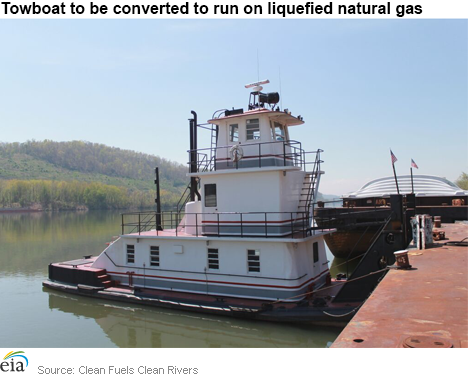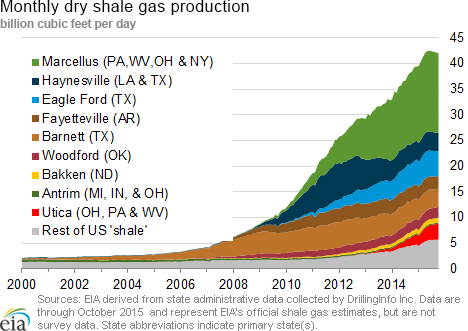In the News:
U.S. Maritime Administration approves first federal grant for LNG use in maritime applications
In October 2015, the U.S. Maritime Administration (MARAD) awarded a $730,000 federal grant to the Pittsburgh Region Clean Cities (PRCC) initiative for a project that will convert a diesel-powered towboat to also run on liquefied natural gas (LNG). The project is expected to demonstrate the potential development and availability of natural gas conversion technology for smaller scale tug, tow, and harbor vessels used in U.S. coastal and inland waterways; which could support LNG use as an alternative to diesel fuel in meeting U.S. Environmental Protection Agency (EPA) nonroad diesel fuel standards for emissions. There are several main partners in the effort including the naval architectural and marine engineering firm the Shearer Group, Inc.; PRCC; Clean Fuels Clean Rivers; and the Center for Alternative Fuels, Engines, and Emissions at West Virginia University, among other groups.
Although the demonstration project is in the design phase and exact specifications are unknown, the project will build on previous engineering designs provided by the Shearer Group for a 4,200 horsepower LNG-powered Z drive towboat, and a 2,200 cubic meter LNG bunkering barge. As part of the project, PRCC will collect air emissions data from the vessel before and after the conversion to enable operational and emissions comparisons between the use of diesel fuel and LNG as a marine fuel.
Other projects to convert inland waterway vessels are also being pursued in the United States. As one example, Washington State Ferries (WSF) has been evaluating the conversion of several of its vessels from diesel fuel to LNG. After conducting a feasibility study and cost benefit analysis, WSF submitted a Letter of Intent to the United States Coast Guard (USCG) to convert six of its vessels to LNG. Modeling of the emission benefits from the proposed WSF conversion indicates emissions reductions of 89% in particulate matter, 59% in sulfur dioxide, approximately 61% in nitrous oxides, and 28% in carbon dioxide. WSF is currently seeking legislative approval for funding from the State of Washington to move the conversion process forward. If funding is approved, the first scheduled LNG conversion for WSF is expected in 2016.
Although these projects are progressing, challenges to broader LNG use in inland maritime vessels remain. Many tugs and towboats are classified by the USCG as uninspected towing vessels (UTV). Current USCG requirements for UTVs don't include criteria for LNG fueling systems. The PRCC demonstration project is being coordinated closely with the USCG Safety Center, but regulations for LNG use and fueling systems on UTVs will likely need to be addressed before wider use of LNG conversion in these vessels can move forward. Other challenges include the relatively high cost of converting the vessels and the lack of fueling infrastructure currently in place.
Overview:
(For the Week Ending Wednesday, December 9, 2015)
- Natural gas prices are down at virtually all trading locations for the report week (Wednesday, December 2, through Wednesday, December 9). The Henry Hub spot price began the week at $2.17 per million British thermal units (MMBtu) last Wednesday and ended at $2.00/MMBtu yesterday.
- At the New York Mercantile Exchange (Nymex), the January Nymex price began at $2.165/MMBtu last Wednesday and settled at $2.062/MMBtu yesterday.
- Working natural gas in storage decreased by 76 billion cubic feet (Bcf), declining to 3,880 Bcf as of Friday, December 4. The net withdrawal from storage resulted in storage levels 15% above a year ago and 6% above the five-year (2010–14) average for this week.
- The total oil and natural gas rig count fell by 7 units this week, with 737 units in service for the week ending Friday, December 4, according to data from Baker Hughes Incorporated. This is the lowest combined oil and natural rig count since October of 1999. The oil rig count fell by 10 units to 545, and the natural gas rig count increased by 3 units to 192 units.
- The natural gas plant liquids composite price at Mont Belvieu, Texas, increased by 1.3% to $4.86/MMBtu for the week ending Friday, December 4. The prices for ethane and natural gasoline declined by 2.0% and 0.6%, respectively; the prices for propane, butane, and isobutane increased by 2.2%, 3.9%, and 4.5%, respectively.
Prices/Demand/Supply:
Henry Hub price dips below symbolic $2.00/MMBtu. Following a record-warm October, continuing growth in natural gas production, record underground natural gas storage levels, and the projected continuation of mild winter weather, the Henry Hub price closed at $1.98/MMBtu on Tuesday and $2.00/MMBtu yesterday. Prior to this week, the Henry Hub spot price has only closed below $2.00/MMBtu on 20 trading days since 2002. During the summer of 2012, when natural gas storage stocks were very high following an unusually mild winter, prices dipped into the $1.80-$1.90/MMBtu range for a few days. That summer, the ample supply of low-priced natural gas was absorbed in large part by the electric power sector.
Natural gas prices are typically elevated during the winter, when residential heating demand competes with other sectors for supply and draws down storage stocks. This winter, however, as expected, prices have remained low, and market participants anticipate that low natural gas prices will continue; the average futures price contract for the remaining winter months (January, February, and March), which can serve as an indicator of market expectations, was only 11¢ above the Henry Hub price yesterday.
Spot prices down across the board on mild weather. During this report period, weather was much milder overall compared to the previous period, particularly Tuesday and yesterday.
The Henry Hub spot price began the week at $2.17/MMBtu last Wednesday and closed yesterday at $2.00/MMBtu. Prices at the Chicago Citygate began the report week at $2.20/MMBtu and closed the week down, at $2.04/MMBtu. Prices at two key import points into the West -- Northwest Sumas (into Washington) and Kingsgate (into Idaho) -- both fell substantially over the report week, with Sumas falling by 27¢ to $1.92/MMBtu, and Kingsgate falling by 28¢ to $1.85/MMBtu.
Prices down in Northeastern locations. New England prices decreased as a result of slightly warmer weather. Algonquin Citygate, which serves Boston-area consumers, fell from $3.06/MMBtu last Wednesday to $1.82/MMBtu yesterday, a decrease of 41%. Transco Zone 6 NY, serving New York City, fell from $2.18/MMBtu last Wednesday to $1.77/MMBtu yesterday.
Marcellus prices down. Marcellus prices featured similar movements to prices elsewhere in the country. At Tennessee's Zone 4 Marcellus trading point, prices began at $1.26/MMBtu last Wednesday and fell to $1.07/MMBtu yesterday. Similarly, on Transco's Leidy Line, prices decreased from $1.26/MMBtu to $1.10/MMBtu Wednesday-to-Wednesday.
Nymex prices down. At the Nymex, the January contract began at $2.165/MMBtu last Wednesday, and ended the report week down over 10¢, closing at $2.062/MMBtu yesterday. The 12-month strip, which averages the January 2015 through December 2016 Nymex prices, closed at $2.347/MMBtu yesterday, 6¢ lower than last week.
Storm systems affect Oklahoma and Pacific Northwest. A winter storm that hit Oklahoma on November 28-29 left over 180,000 Oklahoma Gas and Electric customers without power. Outages continued through Friday, December 4, but power should now be restored to customers. Then on Tuesday of this week, a storm system brought strong winds and rain to the Pacific Northwest, cutting off power to more than 100,000 customers. Natural gas consumption for electric generation in the Pacific Northwest dipped on Tuesday and yesterday, likely as a result of demand destruction from the storm.
Supply increases. Natural gas supply this week increased, driven by both increased dry production and imports from Canada. Dry natural gas production and imports from Canada both increased by 0.5 Bcf/d, or 0.7% and 10.5%, respectively. Liquefied natural gas sendout remained at minimal levels. Overall supply averaged 77.6 Bcf/d for the week, which is 1.2% higher than last week and 0.8% lower than this week last year.
Consumption decreases slightly. U.S. consumption of natural gas decreased by 1.1% compared to the previous report week, led by a decrease in the residential/commercial sector. Residential/commercial consumption fell by 3.4% this week, or 1.1 Bcf/d, as a result of warmer weather, particularly on Tuesday and yesterday. Consumption in other sectors increased modestly, but these increases did not offset the decrease in residential/commercial consumption. Consumption for power generation increased by 0.9%, industrial consumption increased by 0.2%, and exports to Mexico increased by 14.6%. Exports to Mexico only account for about 4% of total disposition.
Storage
Net storage withdrawal is larger than the five-year average and larger than last year's withdrawals for the report week. With the second week of positive net storage withdrawals, the working natural gas inventory for the storage week ending December 3 totaled 3,880 Bcf, which was 514 Bcf (15%) higher than last year at this time and 236 Bcf (6%) higher than the five-year average for this week. The net withdrawal for the storage week was 76 Bcf compared with the 53 Bcf net storage withdrawal reported the previous week. This withdrawal compares with the five-year (2010–14) average net withdrawal of 65 Bcf for the week and last year's withdrawal of 47 Bcf for the same week.
Storage withdrawals are larger than market expectations. Market expectations, on average, called for a withdrawal of 65 Bcf for this week. When the EIA storage report was released at 10:30 a.m. on December 10, the January Nymex price rose about 2¢/MMBtu to about $2.09/MMBtu, and it fell by about 4¢/MMBtu to $2.05/MMBtu in the following hour.
Temperatures during the storage report week are warmer than normal. Temperatures in the Lower 48 states averaged 43°F for the storage report week, 3°F warmer than the 30-year normal temperature and 2°F warmer than the average temperature during the same week last year. There were 155 population-weighted heating degree days (HDD) during this report week, 4 HDD more than the five-year average and 13 HDD fewer than during the same period last year.
See also:
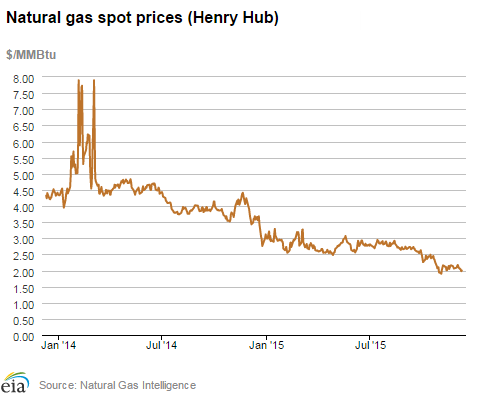
| Spot Prices ($/MMBtu) | Thu, 03-Dec |
Fri, 04-Dec |
Mon, 07-Dec |
Tue, 08-Dec |
Wed, 09-Dec |
|---|---|---|---|---|---|
| Henry Hub |
2.11 |
2.08 |
2.03 |
1.98 |
2.00 |
| New York |
2.10 |
1.87 |
2.05 |
2.00 |
1.77 |
| Chicago |
2.11 |
2.11 |
2.05 |
2.00 |
2.04 |
| Cal. Comp. Avg,* |
2.37 |
2.33 |
2.33 |
2.18 |
2.28 |
| Futures ($/MMBtu) | |||||
| January contract |
2.181 |
2.186 |
2.067 |
2.070 |
2.062 |
| February contract |
2.232 |
2.247 |
2.132 |
2.127 |
2.117 |
| *Avg. of NGI's reported prices for: Malin, PG&E citygate, and Southern California Border Avg. | |||||
| Source: NGI's Daily Gas Price Index | |||||
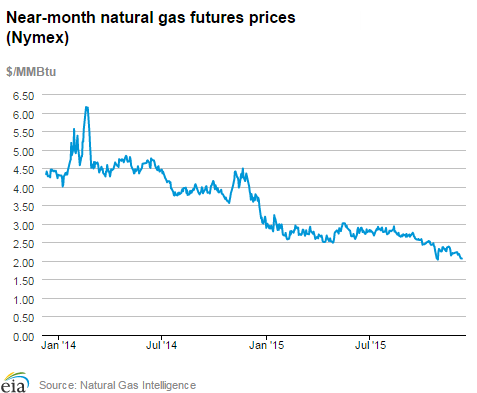
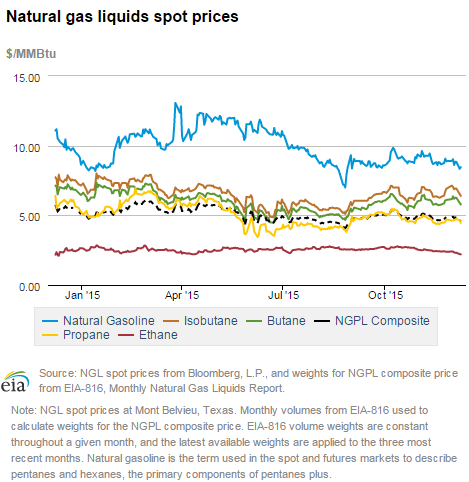
| U.S. natural gas supply - Gas Week: (12/2/15 - 12/9/15) | ||
|---|---|---|
Percent change for week compared with: |
||
last year |
last week |
|
| Gross production | -0.47%
|
0.67%
|
| Dry production | -0.47%
|
0.66%
|
| Canadian imports | -6.29%
|
10.52%
|
| West (net) | 6.20%
|
10.06%
|
| Midwest (net) | 7.34%
|
4.15%
|
| Northeast (net) | -71.83%
|
127.95%
|
| LNG imports | 45.72%
|
-28.15%
|
| Total supply | -0.84%
|
1.22%
|
| Source: BENTEK Energy LLC | ||
| U.S. consumption - Gas Week: (12/2/15 - 12/9/15) | ||
|---|---|---|
Percent change for week compared with: |
||
last year |
last week |
|
| U.S. consumption | -3.0%
|
-1.1%
|
| Power | 12.6%
|
0.9%
|
| Industrial | -2.3%
|
0.2%
|
| Residential/commercial | -12.3%
|
-3.4%
|
| Total demand | -1.6%
|
-0.6%
|
| Source: BENTEK Energy LLC | ||
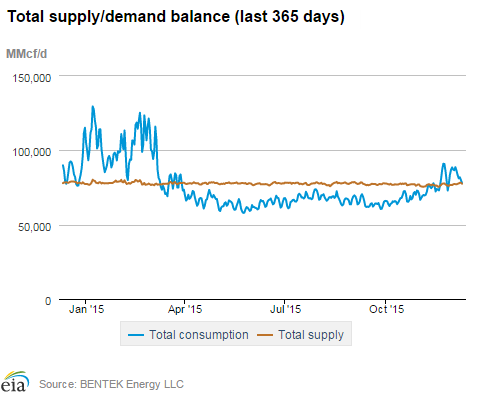
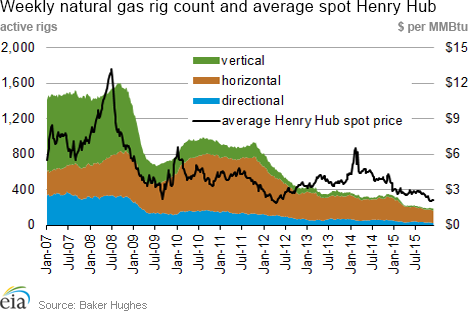
| Rigs | |||
|---|---|---|---|
Fri, December 04, 2015 |
Change from |
||
last week |
last year |
||
| Oil rigs | 545 |
-1.80% |
-65.40% |
| Natural gas rigs | 192 |
1.59% |
-44.19% |
| Miscellaneous | 0 |
0.00% |
-100.00% |
| Rig numbers by type | |||
|---|---|---|---|
Fri, December 04, 2015 |
Change from |
||
last week |
last year |
||
| Vertical | 104 |
-4.59% |
-70.62% |
| Horizontal | 569 |
0.00% |
-58.41% |
| Directional | 64 |
-3.03% |
-67.68% |
| Source: Baker Hughes Inc. | |||
| Working gas in underground storage | ||||
|---|---|---|---|---|
Stocks billion cubic feet (bcf) |
||||
| Region | 2015-12-18 |
2015-12-11 |
change |
|
| East | 894 |
894 |
0 |
|
| Midwest | 1,051 |
1,066 |
-15 |
|
| Mountain | 198 |
203 |
-5 |
|
| Pacific | 346 |
361 |
-15 |
|
| South Central | 1,325 |
1,322 |
3 |
|
| Total | 3,814 |
3,846 |
-32 |
|
| Source: U.S. Energy Information Administration | ||||
| Working gas in underground storage | |||||
|---|---|---|---|---|---|
Historical comparisons |
|||||
Year ago (12/4/14) |
5-year average (2010-2014) |
||||
| Region | Stocks (Bcf) |
% change |
Stocks (Bcf) |
% change |
|
| East | 822 |
10.7 |
886 |
2.7 |
|
| West | 955 |
13.4 |
1,027 |
5.5 |
|
| Producing | 173 |
17.3 |
205 |
-1.0 |
|
| Total | 3,366 |
15.3 |
3,644 |
6.5 |
|
| Source: U.S. Energy Information Administration | |||||
| Temperature -- heating & cooling degree days (week ending Dec 03) | ||||||||
|---|---|---|---|---|---|---|---|---|
HDD deviation from: |
CDD deviation from: |
|||||||
| Region | HDD Current |
normal |
last year |
CDD Current |
normal |
last year |
||
| New England | 164
|
-35
|
-36
|
0
|
0
|
0
|
||
| Middle Atlantic | 146
|
-43
|
-53
|
0
|
0
|
0
|
||
| E N Central | 187
|
-30
|
-48
|
0
|
0
|
0
|
||
| W N Central | 237
|
-7
|
-43
|
0
|
0
|
0
|
||
| South Atlantic | 81
|
-50
|
-48
|
16
|
6
|
10
|
||
| E S Central | 78
|
-57
|
-47
|
0
|
-1
|
0
|
||
| W S Central | 107
|
9
|
20
|
5
|
1
|
0
|
||
| Mountain | 247
|
40
|
96
|
0
|
0
|
0
|
||
| Pacific | 127
|
19
|
56
|
0
|
-1
|
0
|
||
| United States | 155
|
-16
|
-13
|
4
|
2
|
2
|
||
|
Note: HDD = heating degree-day; CDD = cooling degree-day Source: National Oceanic and Atmospheric Administration | ||||||||
Average temperature (°F)
7-Day Mean ending Dec 03, 2015
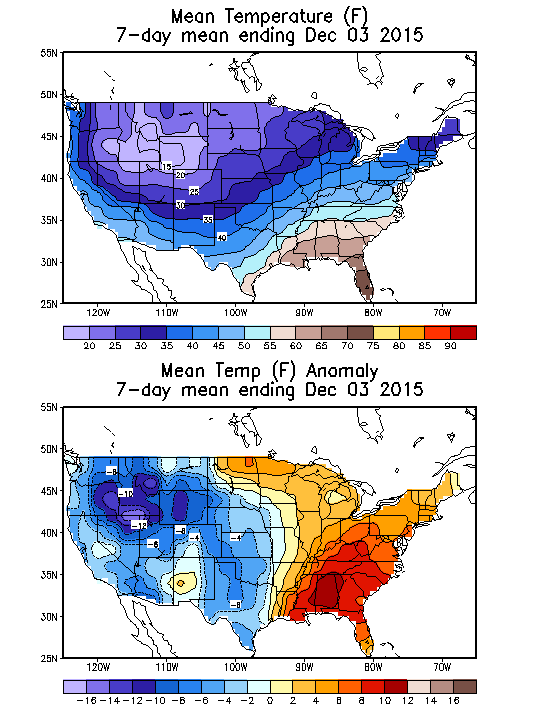
Source: NOAA/National Weather Service
Deviation between average and normal (°F)
7-Day Mean ending Dec 03, 2015

Source: NOAA/National Weather Service

